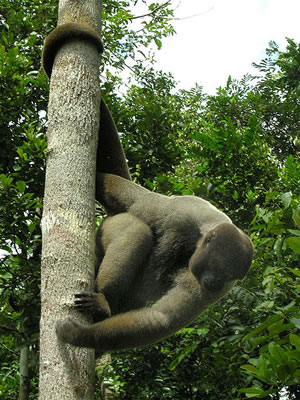South American monkeys have prehensile tails that can be used for a variety of tasks, such as climbing as well as gathering and holding food.
The prehensile tail acts as a fifth limb. It is a continuation of the backbone. It has a central core of bony vertebrae that are joined together in a much more flexible fashion than those of the back.
These vertebrae are bound together with ligaments. The muscles of the tail are attached to the vertebrae by strong tendons. As the muscles at the base of the tail contract, the tail tip curls around so that it can be used as a hook.
In the spider monkey, the prehensile tail may be one and a half times as long as the body, and longer and thicker than the legs.
A slender, wiry animal, the spider monkey uses its powerful tail as skillfully as it uses its arms and legs as it moves swiftly through the forest.
The prehensile tail is flattened rather than cylindrical. The underside is naked and its skin is tough, similar to that of the human palm, and crisscrossed with a network of fine grooves. These grooves, or "dermatoglyphics", resemble the fingerprint patterns on human fingers and serve the same function, that is, to increase friction.
Each monkey is thought to have its own characteristic dermatoglyphics. However, unlike the human hand and fingers, the underside of the prehensile tail is not well endowed with sweat and sebaceous glands.
 The muriqui, or woolly spider monkey, and the woolly monkey are two other South American monkeys with well-developed prehensile tails.
The muriqui, or woolly spider monkey, and the woolly monkey are two other South American monkeys with well-developed prehensile tails.
In all of these monkeys, the thumb and big toe have become reduced in size. In the woolly spider monkey, for example, the thumb is reduced to a fine scalelike flake.
The South American monkeys spend most of their lives high in the trees, rarely venturing to the ground.
Their enemies include the harpy eagle, which usually feeds on juveniles.
Other animals of the tropical rainforest with prehensile tails include the bicolored spined porcupine.
Monkeys of the African tropical rainforest do not have prehensile tails. Nevertheless, they are well adapted to their habitat. These monkeys run along branches and leap across wide gaps between the canopy trees using well developed thumbs and big toes. They have long, bushy tails which give them directional stability and balance